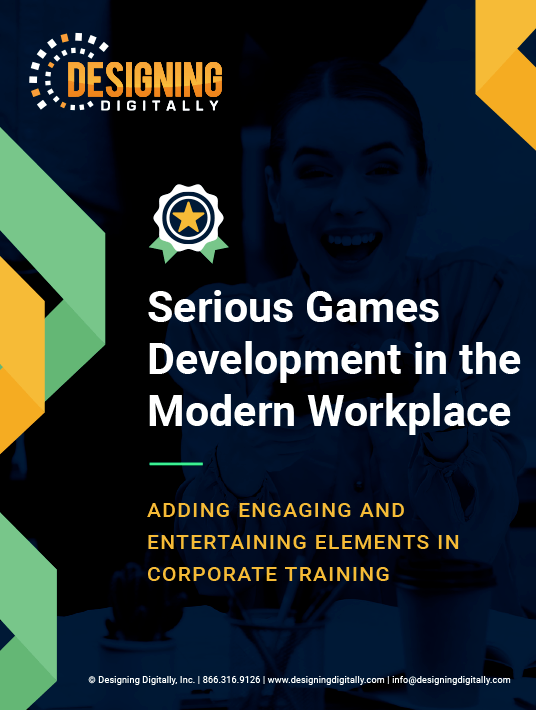Leveraging Serious Games Trends
Games have been around for thousands of years. From Tic Tac Toe and Hangman to Tetris and Super Mario Brothers, games have also evolved a lot. Modern-day technology now makes it possible for most of us to access any type of game with the touch of a button. The sheer number and types of games available out there is astonishing. Few of us could ever have imagined that 2.2 billion people will be connecting on or off-line with the sole purpose of playing a game. And, the trends in serious games tell us that game-based learning continues to make headway.

This brings us to the intrinsic motivations for which people play games:
- Fun
- Relaxation
- Freedom to make mistakes
- Gain new skills
- Keep their memory fresh
- Increase their processing speed
- Learn to multitask
Keep in mind that serious games are built for more than pure entertainment. Their end aim is to educate, to teach the player new skills, and help them acquire new knowledge. This is usually in the context of increasing job performance, employee productivity, and raising the company bottom line. The game should definitely still be fun, but it should also provide the right information, in the right format, and at the right time. Bite-size information, delivered in an enjoyable way, that has a practical application on the job is the best learning format for serious games. Mixing gamification with Just-In-Time and microlearning will lead learners to increase their knowledge retention and decision-making processes.
The Thing About Games
As with any technology, it's new, then it gets old, then it's obsolete. So how are serious games different? What makes Game-Based Learning (GBL) more successful and enduring? To discuss the direction in which serious games are moving, we must start by discussing the current issues associated with them.
It is from 'mistakes' that we humans learn. So, it stands to reason that we revise our game platform every so often in order to maintain player engagement levels. Engagement levels are the most important factor in the growth of your Learning and Development culture. Thus, you must first design a serious game that adapts to player needs and adjusts difficulty based on skill level. And yes, the game design must be visually pleasing as well.
There are 5 venues that creators and developers are exploring to improve serious games' shelf-life. These trends are a direct result of user feedback. And so, the work of a game designer never tires.
Maintaining or increasing employee engagement with the game, while adding new information, are the top challenges for serious game developers.
1. Increasing Engagement
To increase serious game engagement, as stated, the planning and development stage should deliver a flexible, growth-enabling game wireframe. If your platform and programming don't allow for future game expansion, your employees will lose interest in this training method. Also, a game that doesn't grow, doesn't allow for growth. So, a serious game used for induction or onboarding might very well serve its purpose. But, a game that can teach new skills and knowledge across multiple departments is a real gem.
Thus, the platform you choose to run the training game on needs to include the latest technology. The minds behind the programming must also be forward-thinking and set the ground for game improvement. So, making sure the game is increasing engagement is essential in pushing the envelope for eLearning and game-based learning development.
2. Making It Adaptive
A serious game, once adopted into your training strategy, needs room to expand. If you design a soft skills game meant to improve communication, empathy, and listening skills among employees, it will need to offer the option for personalized learning paths. Otherwise, the game will become repetitive and boring which leads to decreased engagement. Personalized learning paths are easy to customize once you know your employees' needs and personal learning goals. Basically, these would be your steps:
- Socialize with and get to know the people who work for you.
- Charge managers with helping create a nurturing, learning-oriented environment.
- Concentrate your findings into customizing your serious game.
- Allow the game to generate personalized learning paths based on employee preferences and level of knowledge.
- Keep the conversation going.
This brings us to the next trend: the need for social interaction.
3. Socially Bound
Social media has always had a soft spot for gaming. As such, game creators and developers get a natural boost from social media channels. People like talking about games, playing with friends, and sharing games. This has been the case lately for serious games. And, that's because, aside from having fun, humans also enjoy learning.
The trend in online social circles is boosting serious game recognition. People and companies are using them to create a new type of conversation—one in which 'self-learning' through eLearning and GBL is a serious goal. This happens when you build a game that is equally fun and educational.
4. Cross-Industry Use
Serious games are used in many industries, including health, exercise therapy, and politics. The recruiting and onboarding process of many companies worldwide employ serious games successfully. This is mainly because learning through gaming is enjoyable and it comes with the bonus of learning new, useful skills.
Employees get to build upon their knowledge at the same time as engaging in friendly office competition. And, regardless of your industry, you can also use serious games to boost productivity within the company.
Used as a Just-In-Time or microlearning method, serious games can have huge benefits to the growth of your company. This is because learning through games allows the player to fail and make mistakes without fearing they will fail. They put the player in real-life situations, such as answering a client inquiry, where they are at the center of the action.
Serious games can help employees find multiple solutions to one issue through the use of branching. Branching scenarios can deepen the knowledge of the player as well as provide a new perspective. Imagine that you had to diagnose a patient in a limited period of time. The symptoms might be telling you he could be suffering from various ailments. But, finding out which ailment is not as important as it would be to treat that particular ailment on time. Therefore, with various scenarios available, health students can explore a disease or its causes in-depth, without fearing for their patient's death.
5. International Recognition
Then, it does come down to the bottom line. Organizations all over the world are adopting gamification because they see the benefits that come attached.
- Happy employees that stay on longer
- A more relaxed workspace
- Higher employee productivity
- Increased company revenue
The GBL industry is growing and serious games are finding their way into company cultures around the world. Virtual Reality can also be efficiently used in employee training and is fast becoming a corporation favorite. This means that the faster you get on board with this employee training method, the better.
Conclusion
Whether you want in on the serious games game or are curious to learn more, one thing is clear: games are the future! Adopting serious games into your company's Learning and Development culture will give you an edge over the competition and the well-oiled company that goes with it. Since it's important for human beings to grow, it's important for us as leaders to not only help make learning easy but also make it low-stress and fun. We hope these 5 trends in serious games sold you on the idea of gamification. But don't take our word for it! There are tons of companies out there that are reinventing themselves and growing by incorporating GBL into their workplace culture. Are you considering Serious Games for your employee training? Read the eBook Serious Games Development In The Modern Workplace and learn more about the benefits that are gained with game-based learning.

